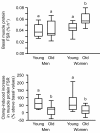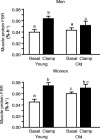Sexually dimorphic effect of aging on skeletal muscle protein synthesis
- PMID: 22620287
- PMCID: PMC3467175
- DOI: 10.1186/2042-6410-3-11
Sexually dimorphic effect of aging on skeletal muscle protein synthesis
Abstract
Background: Although there appear to be no differences in muscle protein turnover in young and middle aged men and women, we have reported significant differences in the rate of muscle protein synthesis between older adult men and women. This suggests that aging may affect muscle protein turnover differently in men and women.
Methods: We measured the skeletal muscle protein fractional synthesis rate (FSR) by using stable isotope-labeled tracer methods during basal postabsorptive conditions and during a hyperaminoacidemic-hyperinsulinemic-euglycemic clamp in eight young men (25-45 y), ten young women (25-45 y), ten old men (65-85 y) and ten old women (65-85 y).
Results: The basal muscle protein FSR was not different in young and old men (0.040 ± 0.004 and 0.043 ± 0.005%·h-1, respectively) and combined insulin, glucose and amino acid infusion significantly increased the muscle protein FSR both in young (to 0.063 ± 0.006%·h-1) and old (to 0.051 ± 0.008%·h-1) men but the increase (0.023 ± 0.004 vs. 0.009 ± 0.004%·h-1, respectively) was ~60% less in the old men (P = 0.03). In contrast, the basal muscle protein FSR was ~30% greater in old than young women (0.060 ± 0.003 vs. 0.046 ± 0.004%·h-1, respectively; P < 0.05) and combined insulin, glucose and amino acid infusion significantly increased the muscle protein FSR in young (P < 0.01) but not in old women (P = 0.10) so that the FSR was not different between young and old women during the clamp (0.074 ± 0.006%·h-1 vs. 0.072 ± 0.006%·h-1, respectively).
Conclusions: There is sexual dimorphism in the age-related changes in muscle protein synthesis and thus the metabolic processes responsible for the age-related decline in muscle mass.
Figures


References
-
- Lee SJ, Janssen I, Heymsfield SB, Ross R. Relation between whole-body and regional measures of human skeletal muscle. Am J Clin Nutr. 2004;80:1215–1221. - PubMed
-
- Gallagher D, Ruts E, Visser M, Heshka S, Baumgartner RN, Wang J, Pierson RN, Pi-Sunyer FX, Heymsfield SB. Weight stability masks sarcopenia in elderly men and women. Am J Physiol Endocrinol Metab. 2000;279:E366–375. - PubMed
-
- Hughes VA, Frontera WR, Roubenoff R, Evans WJ, Singh MA. Longitudinal changes in body composition in older men and women: role of body weight change and physical activity. Am J Clin Nutr. 2002;76:473–481. - PubMed
Grants and funding
LinkOut - more resources
Full Text Sources
Other Literature Sources

